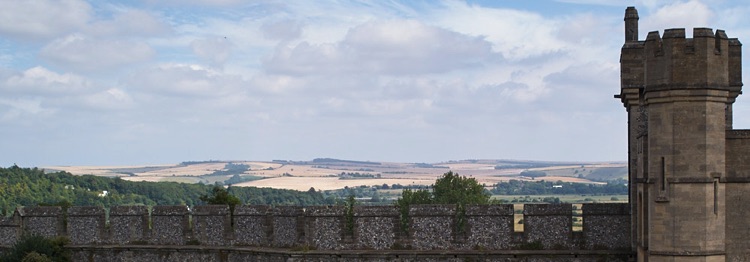
History
286 - Roman times
A fort was built at Pevensey between 280 and 300 by Carausius, a Roman admiral and self-styled emperor of Britain and northern Gaul. The fort was part of the roman defenses against Saxon raiders. Anderitum, as the fort was known in roman times, was built to control the coastal defenses between Porchester and Lympne. Anderitum was originally built on a peninsular surrounded by marsh and sea. However, the sea has now retreated and the castle is about two miles from the sea.
450 - Saxon times
The Saxon invasion of England began around 450. In 491 Ælle and Cissa landed at Pevensey and sacked the roman fort of Anderitum. All the defenders were slaughtered by Ælle. The fort remained in Saxon hands until the Norman invasion, although from the later 900’s on there were frequent Viking raids all along the Sussex coast.
In 1049 Earl Swein landed at Pevensey with his brothers to discuss Swein’s land rights with his father Earl Godwine and with Earl Beorn. The discussion ultimately resulted in Earl Beorn’s murder and Earl Swein’s banishment.
1066 - Norman times
29 September 1066, William of Normandy landed in England, near Pevensey and encamped within the Roman walls at Pevensey en-route to Hastings. He later met the Saxon king, Harold Godwine, in the Battle of Hastings at Senlac field, near present day Battle. After defeating Harold, William gave Pevensey to his half-brother, Robert of Mortain, who built a stronghold inside the old Roman fort. Later, around 1100, a large keep was built. Around 1102, the earl of Mortain lost all his English property to the king, who gave it to a more loyal family, the earl of Laigle from southern Normandy. In 1088, it was held by Robert de Mortain against William Rufus for six months until food ran out. Pevensey was held for the Empress Matilda against King Stephen in 1147. Simon De Montfort was unsuccessful in his attempt to take the castle, after his victory over King Henry III at the Battle of Lewes.
1154 - Plantagenet times
In 1215, the earl Laigle supported Prince Louis in the Barons Rebellion. However, the men of Sussex did not favor the French prince and were loyal to king John. King John, grateful for their support sent letters of thanks to his supporters. His letter of thanks to the men of Seaford still survives. The Laigle family held Pevensey until 1270 when the male line died out and the castle past to Henry III and queen Eleanor.
In 1377, during the hundred years war, the French attacked Pevensey, but were driven off by the Earl of Salisbury and his brother Sir John Montagu. The Earl, his brother and 500 men had been stationed there by King Richard II specifically to guard against such an occurrence.
In 1399 Sir John Pelham, the constable of Pevensey joined Henry Bolingbroke on his return from exile. The castle was attacked by the local sherriff and militia who remained loyal to King Richard II, but they were unsuccessful. King Richard II was eventually confronted by Henry in Conway, where he was forced to abdicate. Henry Bolingbroke was crowned as Richard II successor, King Henry IV. Sir John became one of Henry's most trusted councilors
Pevensey Castle
Highlights
One of the "Saxon Shore" forts built the Romans
Norman castle built inside Roman walls
Dungeon and oubliette
Local museum nearby
Visitor Information
Open year round with paid admission, free for members of English Heritage
Parking and public bathrooms next to castle
½ mile walk from the Pevensey Bay railway station
Refreshments available in the village
Gallery
Map
Website



